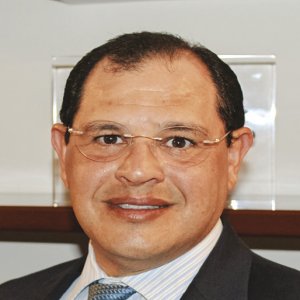A Steady Hand on the Tiller

STORY INLINE POST
The key to PEMEX’s transformation is in the implementation of the 2017-2021 Business Plan, which clearly outlines profitability as the guiding principle of the company across all its business lines. This plan meets the dual mandate that President Enrique Peña Nieto gave me by appointing me CEO: accelerate the implementation of the Energy Reform and improve the finances of the company.
In 2016, a great effort was made to implement austerity and discipline and operational adjustments were made to take advantage of the alliances that, thanks to the Energy Reform, we can now participate in. The results are beginning to be seen and today PEMEX has stable — unlikely but stable — finances.
Recently, rating agency Moody’s acknowledged the company's financial efforts and its track record in the past year and awarded PEMEX an overall PAA3 foreign currency credit rating. In addition, PEMEX recorded a positive net financial result for two consecutive quarters, something that had not been achieved in six years. This is mainly due to the recovery of crude oil prices, the recognition of logistics costs in the price formula for gasoline and diesel and the decrease in the company’s operating costs.
With respect to crude oil production, PEMEX will reach its annual target. During the first few months of the year, a considerable recovery was achieved in the crude oil process compared to the end of 2016. Thanks to the strengthening of exploration and extraction processes, it has been possible to maintain an average of around 2 million b/d. Ku-Maloob-Zaap has maintained its production volume of above 860,000b/d, helping to counteract the natural decline of other fields. Together with the evolution of assets such as the Litoral de Tabasco, Tsimin-Xux and the Xanab fields, this has led to a combined increase in production of more than 156,000 barrels, excluding Cantarell.
The Energy Reform is advancing and PEMEX is getting stronger.
PEMEX’s Business Plan
The Business Plan, presented at the end of 2016, is a realistic plan focused on profitability. This plan establishes the actions required to enable the company to achieve financial strength, as well as to stabilize production and subsequently increase it. It is a plan that includes, as a priority, the establishment of alliances and strategic partnerships across the value chain as a mechanism to increase investments, increase operational efficiency and share financial and technological risks.
This plan is already underway and its first results have already been very successful. Last March PEMEX formalized its partnership agreements with the US company Chevron and the Japanese company INPEX, with which we jointly won the CNH tender for the exploration of deepwater Block 3 North. We also signed the contract with Australia’s BHP Billiton, winner of the first farm-out in PEMEX history. Through this partnership, the Trion block will be explored and developed in the Cinturón Plegado Perdido in the ultra-deepwaters of the Gulf of Mexico. These are the first of many partnerships with which PEMEX will consolidate itself as a major oil company.
Three other farm-outs are scheduled for the coming months: in shallow waters, the Ayín and Batsil fields; the Ogarrio and Cárdenas-Mora onshore fields; and in deepwater, Maximino and Nobilis, also located in the Perdido area. Recently, PEMEX also completed the first migration to the new production contracts for the Ek Balam field in the Campeche Sound. This new scheme will allow us to generate greater economic value for the project.
Midstream, Downstream AND Distribution
In terms of refining, PEMEX has begun to form alliances in order to increase the profitability of operations. At the beginning of this year the first partnership for the supply of hydrogen to the Tula refinery with the French company Air Liquide was finalized. This will reduce the number of unscheduled shutdowns, as well as increase the production of gasoline and generate savings of more than 30 percent in this service. Air Liquide also plans to invest in the construction of a second hydrogen plant at the refinery in order to meet the total demand from the expansion at the Tula refinery. The plant’s construction is expected to be completed by the end of 2019.
As part of the efforts to allocate more resources to the central refining processes, we are also forming alliances for the supply of auxiliary services and the reconfiguration of the Salina Cruz and Salamanca refineries in Oaxaca and Guanajuato, respectively. The objective is that PEMEX focuses on the primary activities that allow it to generate more resources.
In terms of logistics and complying with the norm established by CRE, PEMEX is carving out its position as a pillar of the new energy environment. In May, the first phase of the Open Season was carried out, whereby PEMEX allocated storage and pipeline capacity for the states of Baja California and Sonora. One hundred percent of the capacity offered was assigned and the winner was the US company Tesoro. The interest shown by 22 companies registered in the auction confirms the confidence of the private sector in both these processes and in PEMEX and its operational capacity. It certainly constituted an important step in the creation of an efficient and competitive market to efficiently satisfy national demand to the benefit of consumers. Over the next few months, next steps will be taken to cover the rest of the country. In addition to promoting the investment of new participants in the sector, this scheme will enable PEMEX to generate resources for its growth.
Future Outlook
In almost 80 years of activity, PEMEX has accumulated knowledge and experience. It is the eighth-largest oil producer in the world and a leader in shallow waters. The reform passed by President Enrique Peña Nieto in 2013 imposed on PEMEX the challenge of transforming itself into a productive state enterprise. In the period that I have been leading the company, since February 2016, I have verified the capabilities of our workers to drive the required changes to face the complex challenges of the new international environment.
The international industry is aware of PEMEX’s new way of operating and there is a considerable interest in establishing alliances with us. Mexico and, specifically, PEMEX, represent important investment opportunities across various business lines in the hydrocarbons sector. PEMEX is the strategic partner with which to invest in Mexico. I am sure that it will continue to be a pillar of the national industry and the flagship company of the country.























